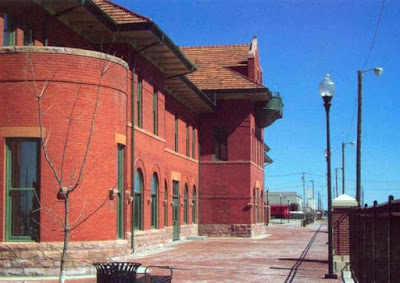trading post industrial hub and regional center of
culture media and trade
Wichita lies on the Arkansas River in south-central Kansas,
157 mi (253 km) north of Oklahoma City, 181 mi (291 km)
southwest of Kansas City, and 439 mi (707 km) east-southeast of
Denver. The Arkansas follows a winding course, south-southeast through Wichita,
roughly bisecting the city.
A Trading Post on the Chisholm Trail in the 1860s, it became a
destination for cattle drives traveling north from Texas to Kansas railroads,
earning it the nickname Cowtown.
Business opportunities attracted area hunters and traders, and a new
settlement was organized as the Wichita Town Company, naming the settlement
after the Wichita tribe. In the early 20th century,
oil and natural gas deposits were discovered nearby triggering an economic boom
in Wichita as producers established refineries, fueling stations, and headquarters
in the city. Resources generated by the oil boom enabled local entrepreneurs to
invest in airplane manufacturing. Except for a slow period in the 1970s, Wichita has
continued to grow steadily into the 21st century as the city
government and local organizations began collaborating to re-develop downtown
Wichita and older neighborhoods in the city.
Neighborhoods include Old Town, a 50-acre area
home to nightclubs, bars, restaurants, a movie theater, shops, apartments and
condominiums, many of which make use of historical warehouse-type spaces. The
two most notable residential areas of Wichita are Riverside and College Hill,
along with Delano on the west side of the Arkansas River and Midtown in the
north-central part of the city.
The Arts Wichita
is a cultural center for Kansas and home to several art museums and performing
arts groups. The Wichita Art Museum is the largest art museum in the state of
Kansas with 7,000 works in permanent collections and the Ulrich Museum of Art
at Wichita State University is a modern and contemporary art museum with over
6,300 works. Small art galleries are scattered around the city with some
clustered in the districts of Old Town, Delano and south Commerce street. The music
hub of central Kansas draws major acts from around the world, performing at
concert halls, arenas and stadiums around the area.
Wichita Transit operates 53 buses on 18 fixed bus routes within the city
providing over 2 million trips per year as well as a demand response
paratransit service with 320,800 passenger trips annually. Intercity bus services
connect Wichita with other Kansas towns, Oklahoma and Colorado. Wichita's Bikeways
cover 115 miles of which one third were added between 201 and
2018












